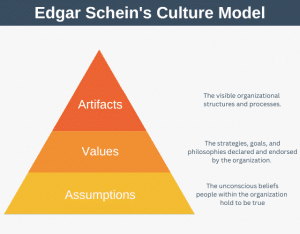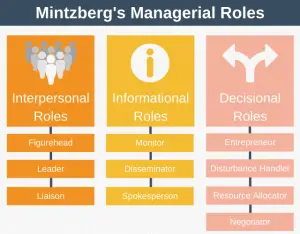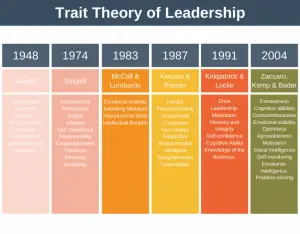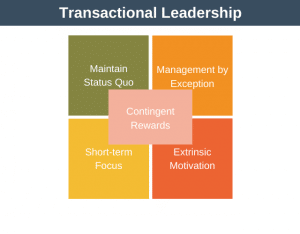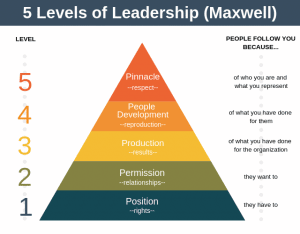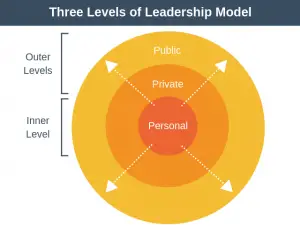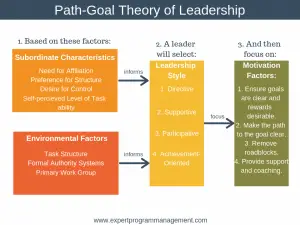When we look at a leader within an organization we may think their power comes from their direct responsibility for others. Whilst this is obviously true, it is also a very superficial way to understand power. In a study conducted by two social psychologists, John R. P. French and Bertram Raven in 1959, they identified 5 Types of Power.
Think of a leader you have worked for that you and your peers’ respect, both for their hard work and for their ability to bring everyone along with them. The type of leader that is a role model that others aspire to be like one day.
Now think of another leader who understands the intricate details of how everything works within the organization. This could be knowledge of the products the organization makes, or it could be expert skill in a particular area.
If you have experience of working with two leaders such as those described above, then you may have felt differently working for each, and probably worked better with one style over the other. This can be explained because the power of each of these leaders came from a different power base, rather than their official job title and line management responsibilities.
The Bases of Power
French and Raven described 5 types of power, sometimes referred to as the 5 bases of social power. Each is described briefly below and then in more detail later.
- Coercive: here power comes from one’s ability to punish someone else for noncompliance, for example, through fear of losing their job or their annual bonus.
- Reward: here power comes from one’s ability to issue rewards, for example, through a bonus or allowing time off in lieu.
- Legitimate: here power comes from a person’s formal right to issue directives or commands because of their position in the organization, for example, the CEO has the right to dictate the strategy.
- Expert: here power comes from one’s experience or knowledge, for example, a senior surgeon displays the expert knowledge for subordinates to trust them.
- Referent: here power comes from being trusted or respected, for example, the boss who treats everyone fairly and with respect.
Several years after identifying these 5 types of power, Raven added a sixth:
- Informational: her power comes from controlling the information that others need in order to achieve something, for example, the boss who gives away a secret about a specific situation.
The reason for learning about the 5 Types of Power is so that we can learn the situations when it is appropriate to use a particular type of power, thus making us more effective managers and leaders.
The 5 Types of Power
The 5 bases of power are split into two categories. Formal power, defined by a person’s position within an organization (sometimes referred to as positional power), and personal power, which is defined by the person’s followers.
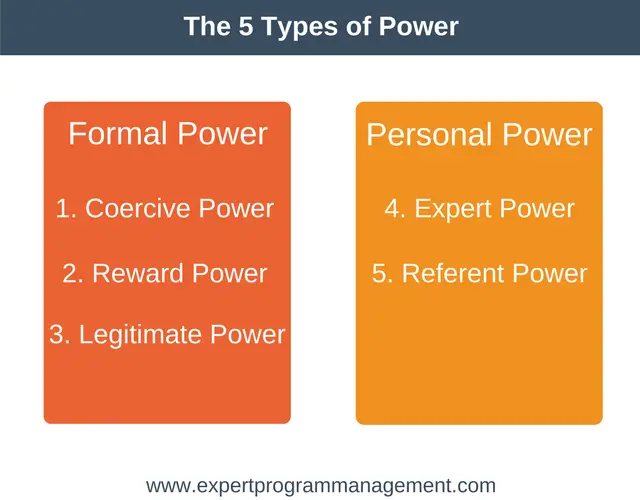
Formal Power Sources
1. Coercive Power
You use coercive power when you threaten that people will be punished in order to gain compliance, such as threatening that they will be fired or demoted unless they hit their objectives.
Coercive power only works when you have visibility of what the person under your power is doing (surveillance). With people who consistently fail to meet the requirements of their role, you may need to wield coercive power, for example, when you put them onto a capability process. Another time when it might be appropriate to use coercive power is when an organization is in crisis or cuts are threatened, for example, if a business unit needs to make cutbacks.
Otherwise, using coercive power is rarely useful in a professional environment as it creates resentment and can lead to accusations of bullying.
2. Reward Power
You use reward power when you use rewards to achieve compliance with your wishes. Examples of rewards include bonuses, pay increases, days off in lieu, training opportunities, or even simply a public compliment or thank you.
The trick to using reward power is to create the expectation of a reward and trigger that part of the brain that enjoys being rewarded for hard work. As a simple example, if you always publically praise your high performers and never praise your poor performers, then you create a desire in others to achieve that praise by working hard to get it.
Note that with the exception of praise and thanks, it’s possible to either run out of rewards or not have the ability to issue them. In this case, your power becomes diminished. For this reason, it is advisable to use praise and thanks frequently, and other rewards very infrequently and only for major achievements.
3. Legitimate Power
You use legitimate power when you use your position in the organization to achieve compliance with your wishes. With legitimate power, the subordinate complies with your wishes because they believe that you have a right to wield such power because of the position you hold.
A CEO holds legitimate power. So does a president who has been given a mandate by an election. Legitimate power is determined by title but also by the situation: an ex-president cannot issue orders to the military, and while a currently serving president can issue military orders, they cannot tell their citizens to eat healthily, as their power doesn’t exist in that situation.
Legitimate power will be weakened within an organization if there isn’t a very clear organizational structure and chain of command. This can be a disadvantage of working in a matrix organization.
Personal Power Sources
1. Expert Power
You use expert power when you use vast experience in a particular area and a past history of demonstrating solid judgment in that area to achieve compliance with your wishes. Subordinates clearly believe that your past experience will guide you to make the right decision. Essentially, you are a thought leader in a specific topic or domain.
Expert power doesn’t just come in the form of people having witnessed your experience develop, it can also come from reputation or qualifications. It is worth noting that this expertise doesn’t have to actually exist, but that the perception of this expertise must.
Some pitfalls exist when relying on expertise to wield power, for example, expertise doesn’t last forever, so an expert promoted to a management position because of their expertise with a particular IT system, will find that their knowledge of that system diminishes over time as both the system changes and they spend increasing amounts of time focussed elsewhere. Because of this, it is advisable to still be amenable to the opinions of others even if you are established as an expert in your field.
2. Referent Power
You use referent power when you use your status as a trusted and respected role model to achieve compliance with your wishes. Organizational leaders and managers who have referent power have frequently gained this power over time by modeling the behavior they expect to see in others over a long period of time.
Reverent power is also gained over time by delegating increased authority and autonomy to subordinates. In general society, celebrities have referent power, which is why they are often paid a lot of money to advertise products to us. Their status as a role model makes us want to be like them and so we buy products that they promote as we think it will make us more like them.
In order to build your referent power in an organization, you’ll need a low rate of employee turnover and the ability to build close personal relationships. This is because it takes time to build referent power. You can learn more about referent power here.
How to Apply the 5 Types of Power
It is important to understand the 5 Types of Power because they have a huge impact on employee engagement, employee motivation, and also organizational culture. There are two main situations where the 5 Types of Power can be applied in the workplace:
- If you find yourself in a leadership position and you want to get something achieved. In this situation think about what you would like to get achieved and which type of power you’re naturally drawn to. Check the list of power types to see if there is a better power base to approach the situation from. Remember to think not just about the thing you want to achieve right now, but also the other implications, such as company culture and how others will perceive you.
- If you feel powerless. It might not seem obvious but we all hold a little power even in the most challenging situations. Check the list of power bases and see how you can take back some power from the situation.
The ability to change both your leadership style and the power base from which you operate are important skills in situational leadership. The reason for this is because if you approach a problem from the perspective of each power base, then each power base will have a varying degree of effectiveness.
The 5 Types of Power Summary
In 1959, two social psychologists, John R. P. French and Bertram Raven identified five underlying bases of power, as follows:
- Coercive power
- Reward power
- Legitimate power
- Expert power
- Referent power
Later a sixth type of power was introduced, Informational power.
Power, and how it is used can impact your relationship with colleagues, organization culture, and employee engagement and motivation. It can be a good idea to check the list of power types before an important conversation to ensure you are approaching the interaction from the best possible power base.

